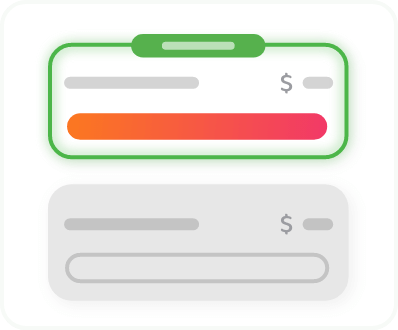제어권을 되찾으세요.
Private Internet Access: 디지털 개인 정보 보호를 위한 최고의 VPN
- 전 세계 서버 무제한 액세스
- 초고속 스트리밍 및 파일 공유
- 주 7일 24시간 기술 전문가 대기 중


다음을 포함한 기업에서 PIA VPN을 신뢰합니다.






30일 환불 보장
개인 정보 보호
우리는 모두 온라인상에서 프라이버시가 필요합니다. IP 주소와 검색 기록은 불필요한 감시로부터 보호받아야 하죠. PIA의 가상 개인 네트워크는 사용 로그를 절대로 보관하지 않으니 안심하셔도 좋습니다.


데이터 보호
데이터를 암호화하여 보안을 강화하세요. 암호화되지 않은 이메일, 사진, 은행 정보 등 비공개로 유지되어야 하는 그 어떤 정보에도 다른 사람이 접근하지 못하도록 하세요.
모든 인터넷에 접속
인터넷 제공 업체의 스로틀링 및 성가신 네트워크 제한 없이 좋아하는 모든 컨텐츠을 이용할 수 있습니다. 대역폭 제한 없이 세계 최고의 프로그램, 앱 및 게임을 계속 즐길 수 있습니다.

보안 강화를 위한 프리미엄 애드온

개인 정보 보호 우선
바이러스 백신
저희의 최신 바이러스 백신 소프트웨어는 사용자 활동을 추적하거나 연결 데이터를 기록하지 않고도 윈도우 PC에서 멀웨어를 스캔 및 제거하므로, 사용자가 데이터와 디지털 개인 정보를 완벽하게 제어할 수 있는 유일한 바이러스 백신입니다.

전용 IP 주소
고객님만 사용할 수 있는 고유 IP 주소를 이용하세요. 제한된 콘텐츠 이용 및 온라인 활동 숨기기와 같은 VPN의 모든 혜택을 누리는 동시에 온라인 뱅킹 및 게임과 같은 작업을 수행할 때 캡차 표시 횟수를 줄이고 안정성을 높이려는 경우에 유용합니다.
수백만 고객의 만족스러운 후기
다음은 가장 긍정적인 사용자 후기 중 일부입니다. Trustpilot 전체 후기는 여기를 참고하세요.
{"tweetsBtnText":"{Tweets}","userBtnText":"{User Reviews}","influencersBtnText":"{Influencers}","techReviewsBtnText":"{Tech Reviews}"}

최고의 요금제를 선택하세요

최신 기능을 이용하세요

노로그
PIA는 어떠한 종류의 사용 데이터도 추적, 기록 또는 저장하지 않습니다. 사용자 개인 정보 보호는 저희 사명의 핵심입니다.

오픈소스
저희 앱은 100% 오픈소스입니다. 누구든지 저희 오픈소스 소프트웨어를 살펴보고 맞춤화할 수 있습니다.

최신 업데이트
Private Internet Access는 WireGuard처럼 가장 우수한 최신 암호화 표준과 VPN 프로토콜을 사용합니다.

빠른 설정
플랜을 선택하고 PIA VPN 앱을 다운로드한 다음 계정을 인증하고 몇 분만에 보호받으세요.

무제한 대역폭
광범위한 서버 네트워크로 제한 없는 인터넷 속도를 누리세요.

광고, 추적기, 멀웨어 차단
PIA의 'MACE' 기능으로 광고, 온라인 추적기, 악성 웹사이트를 차단하세요.

지금 모든 기기용 VPN 다운로드
PIA의 최고 등급 VPN 서비스로 모든 기기를 보호하세요. 91개국에 위치한 차세대 서버에 연결하여 빠른 VPN 연결 속도를 경험하세요.
PC에 Windows 및 Linux 앱을 설치하거나 Mac용 macOS 앱을 설치하세요. Android 스마트폰 및 태블릿에 VPN .apk 파일을 다운로드하거나 Apple 모바일 기기에 iOS 앱을 다운로드하세요.
안전한 브라우징을 위해 Chrome, Firefox 및 Opera용 VPN 확장 프로그램을 설치하세요. 또는 스마트 TV, 게임 콘솔 및 라우터용 스마트 DNS 기능을 사용하세요.

VPN이란?
VPN의 정의는 가상 개인 네트워크입니다. 즉, 안전하고 암호화된 인터넷 연결을 제공하는 서비스입니다. 최근 몇 년간 공공 네트워크에서 온라인 위협이 증가함에 따라 인기있는 사이버 보안 도구가 되었습니다.
PIA VPN은 비공개 보안 서버를 통해 인터넷 트래픽을 재라우팅하여 고객님의 디지털 신원을 보호합니다. 저희는 방대한 고급 VPN 서버로 구성된 글로벌 네트워크를 보유하고 있으며, 최고의 VPN 프로토콜을 사용하여 고객님의 개인 데이터를 암호화합니다.


PIA의 강력한 서버 인프라
PIA VPN은 IPSec(IP 보안 아키텍처) 개방형 프레임워크를 사용하여 정보를 암호화하고 인증합니다. 이 프레임워크는 발신 데이터를 암호화하고 수신 데이터를 인증합니다. 두 경우 모두 데이터는 모든 통신을 처리하는 중간 보안 서버를 통해 전송됩니다. 그렇기 때문에 이러한 서버의 품질이 매우 중요합니다.
PIA는 최고의 하드웨어 구성 요소로 설계 및 최적화된 차세대 서버 네트워크를 보유하고 있습니다. 코로케이션 서버를 통해 제3자 인프라에 접근할 수 없도록 보장합니다. 또한 서버를 10Gbps 네트워크 카드로 업그레이드하여 최대 연결 속도를 지원합니다. 이러한 기능을 통해 가장 안전하고 빠른 연결을 보장합니다.
VPN은 어떻게 작동하나요?
VPN은 인터넷 트래픽을 재라우팅하고, 데이터를 암호화하며, IP를 마스킹합니다. 이를 통해 보안이 강화되고 익명성이 향상됩니다.
온라인 브라우징 시 인터넷 트래픽을 가로채일 수 있습니다. ISP, 네트워크 관리자, 패킷 분석기 등이 사용자의 데이터에 접근할 수 있습니다. 원격 서버를 통해 트래픽 경로를 재지정하면 터널과 유사한 효과가 발생하며, 터널을 통과하는 모든 트래픽은 제3자가 볼 수 없습니다.
개인 네트워크를 사용하면 높은 수준의 암호화를 통해 이점을 얻을 수 있습니다. 데이터를 암호화하면 개인 정보를 안전하게 보호할 수 있습니다.


VPN이 켜져 있을 때 추적당할 수 있나요?
최고급 VPN을 사용하면 제3자가 고객님의 온라인 활동을 추적할 수 없습니다. PIA의 VPN 서버는 인터넷 트래픽을 실시간으로 재라우팅 및 암호화하며 사용자의 IP 주소를 마스킹합니다. PIA를 사용하면 ISP, 정부 기관 및 사이버 범죄자가 고객님의 온라인 활동을 모니터링하고 위치를 정확히 파악할 수 없습니다.
IP 주소를 숨기면 웹사이트 및 추적기가 고객님의 온라인 활동을 식별하지 못하게 할 수 있습니다. 이렇게 하면 여행 중에도 익명성을 유지하고 네트워크 차단을 우회할 수 있습니다. VPN은 온라인 익명성과 자유를 향상시키는 데 매우 중요합니다.
VPN 사용의 6가지 장점

가상 위치 변경
PIA의 광범위한 차세대 VPN 서버 네트워크에 연결하여 온라인 위치를 선택하세요. 미국 50개 주를 포함한 91개 국가를 포함합니다.

개인 정보 보호
IP 주소를 숨겨 온라인 신원을 보호하세요. ISP가 고객님의 온라인 활동을 감시하지 못하도록 하세요. 어디서든 안전한 웹 브라우징을 즐기세요.

완벽한 디지털 보안
ISP와 네트워크 관리자가 사용자의 데이터를 저장하거나 판매할 수 없도록 하세요. PIA로 모든 기기를 보호하세요. 모든 네트워크에서 비공개 연결을 즐기세요.

공공 와이파이 보호
공공 네트워크는 개인 정보 보호에 위협이 될 수 있습니다. 스누퍼나 사이버 범죄자가 사용자의 트래픽을 가로채는 것을 방지하려면 기기에 PIA를 설치하세요.

안전한 파일 공유
온라인에서 파일을 공유할 때 IP 주소를 숨기세요. 비공개 파일을 전송하거나 처리할 때 PIA에 연결하여 데이터를 암호화하세요.

안전한 해외 여행
다른 주나 해외로 여행할 때는 현지의 콘텐츠 제한이 적용됩니다. PIA VPN에 연결하여 집에서처럼 안전하게 앱을 이용하세요.
모바일 VPN이란?
모바일 VPN을 사용하면 홈 네트워크와 통신사 등 서로 다른 네트워크 사이를 전환할 때에도 VPN 세션을 유지할 수 있습니다.
PIA VPN은 모든 기기에서 원활하게 연결할 수 있도록 최적화된 모바일 VPN 기능을 제공합니다. 또한 스마트폰과 태블릿을 위한 사용자 친화적인 앱을 제공합니다. PIA의 VPN 앱은 킬 스위치 기능으로 데이터 유출 사고로부터 사용자를 보호하는 데 최적화되어 있습니다.
간단한 3단계로 모든 모바일 기기에 PIA VPN을 설치하세요.

1단계
Private Internet Access에 가입하세요.

2단계
PIA VPN 앱을 다운로드하세요

3단계
전원 버튼을 탭하여 연결하세요

오픈소스 VPN이란?
오픈 소스 VPN은 소스 코드를 공개적으로 공개하므로 누구나 살펴볼 수 있습니다. 투명한 관행을 통해 안정적이고 안전한 소프트웨어를 이용할 수 있습니다. 이것이 바로 오픈 소스 VPN을 훨씬 더 신뢰할 수 있는 이유입니다.
PIA는 최고의 오픈 소스 VPN 중 하나로 알려져 있습니다. 누구나 저희의 VPN 앱과 VPN 프로토콜을 분석하고 안전하고 원활한 연결을 보장하기 위한 저희의 조치를 직접 확인할 수 있습니다. 또한 최고의 오픈소스 VPN 프로토콜인 WireGuard®와 OpenVPN을 사용합니다.
오픈소스 코딩은 또한 협력적 특성으로 인해 성능 향상과 혁신에 도움이 됩니다. 오픈 소스 코드 덕분에 PIA의 커뮤니티 회원들이 제안을 보낼 수도 있습니다.
나에게 적합한 VPN
선택 방법
속도
좋은 속도는 필수입니다. 스트리밍과 게임을 원활하게 지원하는 최고급 고속 서버를 갖춘 VPN을 선택하세요. PIA는 모든 기기에서 버퍼링 없는 스트리밍과 지연 시간 없는 온라인 게임을 즐길 수 있도록 초고속 10Gbps VPN 서버를 보유하고 있습니다. 또한 광범위한 글로벌 VPN 네트워크를 통해 과밀과 혼잡을 피할 수 있습니다.


보안
온라인 보안에 있어 고품질 암호화는 매우 중요합니다. 그렇기 때문에 가장 강력한 암호화 프로토콜을 사용하는 VPN을 선택해야 합니다. 이것이 ISP, 네트워크 관리자 및 정부 기관이 고객님의 데이터에 접근할 수 없도록 하는 유일한 방법입니다. PIA VPN은 가장 강력한 암호화 암호를 제공하며, 128비트 AES 또는 군사급 암호인 256비트 AES 중에서 선택할 수 있습니다.
개인 정보 보호
개인 정보를 보호할 수 있는 VPN을 원합니다. PIA는 엄격한 노로그 정책을 준수합니다. 이 정책은 빅4 기업 중 한 곳에서 실시한 독립 감사를 통해 검토되었습니다. 저희의 로그 없는 서비스는 법정에서 두 번이나 입증되었습니다. 저희는 사용자의 개인 정보 보호 권리를 존중및 지원하며 사용자의 데이터를 보관하거나 저장하지 않으므로 안심하고 사용하실 수 있습니다.


분할 터널링
이 중요한 VPN 기능을 사용하면 사용자 지정 VPN 연결 프로토콜을 설정할 수 있습니다. 예를 들어, 은행 서비스에서 사용자의 활동을 사기 행위로 인식하지 않으려면 IP 주소를 계속 바꾸지 않아야 합니다. 특정 앱 및 웹사이트에 대한 케이스 기반 규칙을 쉽게 설정할 수 있습니다. PIA VPN은 고급 분할 터널링 기능을 제공하므로 자동화된 설정을 생성하고 VPN 터널을 우회할 앱과 도메인을 선택할 수 있습니다.
오픈소스
VPN의 경우, 오픈 소스는 투명성을 위해 매우 중요합니다. 오픈 소스 코드를 사용하면 내부를 들여다보고 VPN이 실제로 어떻게 작동하는지 확인할 수 있습니다. PIA VPN은 최고의 오픈 소스 VPN입니다. 클라이언트 소스 코드를 살펴보고 트래픽과 데이터를 보호하기 위한 저희의 조치를 직접 확인할 수 있습니다.


고급 및 간편 보호 기능
추가 보호 계층이 필요하다면 멀티홉 기능이 있는 VPN을 선택하세요. 더블 VPN이라고도 하는 이 기능을 사용하면 2개의 VPN 서버에 연결하고 익명성을 강화하며 검열을 우회할 수 있습니다. PIA의 멀티홉 기능을 사용하면 데이터 보존을 방지하고 디지털 발자국을 보호하도록 설계된 2 RAM 전용 VPN을 통해 인터넷 트래픽을 재라우팅할 수 있습니다.
요금
온라인 개인 정보 보호와 보안에 관해서는 만족할 수 없습니다. 합리적인 가격대의 신뢰할 수 있고 품질이 우수한 VPN을 선택하세요. PIA VPN은 합리적이고 안정적입니다. 저희 플랜은 최고의 가성비를 제공합니다. /월 에 구독하세요. 30일 환불 보장 정책으로 부담 없이 이용해보세요.


VPN은 합법인가요?
예, VPN은 전 세계 대부분의 국가에서 완전히 합법입니다. 실제로 대부분의 정부는 더 나은 온라인 데이터 안전의 필요성을 이해하고 소비자 보안 도구로서 VPN을 지원합니다. 일부 국가에서는 이러한 인식이 부족하여 감시 기능이 있는 국가 승인 VPN만을 허용하고 있습니다.
점점 더 많은 정책 입안자와 개인이 온라인 개인 정보 보호의 중요성을 이해하기 시작했지만, 인터넷은 아직 안전하고 자유로운 환경이 아닙니다. 디지털 신원을 보호하고, 데이터를 비공개로 유지하며, 자유롭고 안전한 인터넷을 즐기려면 우수한 품질의 VPN이 필요합니다.
무료 VPN을 사용해도 되나요?
무료 VPN을 사용할 수는 있지만 권장하지는 않습니다. 대부분의 무료 VPN은 품질 및 보안과 관련된 몇 가지 공통적인 문제를 가지고 있습니다.
대부분의 무료 VPN은 예산 제약으로 인해 서버 위치 수가 적습니다. 따라서 일반적으로 서버가 혼잡하고 느리며 고객님이 거주하는 국가에 서버가 없을 수도 있습니다.
두 번째 문제는 대부분의 무료 VPN이 오래된 서버를 사용한다는 것입니다. 오래된 하드웨어를 사용하면 사이버 공격에 취약해지고 연결 문제가 발생할 수 있습니다.
대부분의 무료 VPN은 사용자의 데이터를 판매하거나 인앱 광고를 표시하여 수익을 창출합니다. VPN 사용의 주요 목적이 개인 정보를 보호하는 것이므로 이는 중요한 문제입니다.
PIA와 같은 저렴하고 안정적인 VPN을 이용하면 이러한 문제를 피할 수 있습니다. 저희는 91개국에 초고속 차세대 서버를 보유하고 있으며, 암호화를 위해 최고의 VPN 프로토콜을 사용하며, 엄격한 노로그 정책을 준수합니다.
.png)
더 자세히 알고 싶으세요?
VPN은 디지털 신원과 데이터를 보호할 수 있는 사이버 보안 도구입니다. 또한 원활한 브라우징을 위한 빠른 VPN 속도, 연결 속도 저하 회피, 여행 중 좋아하는 콘텐츠 이용, DDoS 및 중간자 공격과 같은 사이버 공격 방지 등 다양한 이점을 제공합니다.
VPN으로 익명성을 완전히 유지할 수는 없지만, 최고급 VPN을 사용하면 온라인 익명성을 강화할 수 있습니다. PIA를 사용하면 온라인 트래픽을 암호화하고 IP 주소를 마스킹하여 디지털 프라이버시를 되찾을 수 있습니다. 고객님의 고유한 IP 주소를 숨기면 ISP 및 기타 제3자가 고객님의 활동을 추적하지 못하게 할 수 있습니다.
노로그 정책은 VPN이 사용자의 데이터를 수집하거나 저장하지 않는다는 것을 의미합니다. 개인 정보 보호에 중점을 둔 서비스라면 당연히 적용되어야 하는 정책이라고 생각할 수 있지만, 안타깝게도 그렇지 않습니다. 일부 서비스는 사용자의 로그를 보관하고 데이터를 판매하여 수익을 창출합니다. 진정한 비공개 인터넷 환경을 즐기고 싶다면, PIA와 같이 엄격한 노로그 정책을 따르는 VPN을 사용해야 합니다.
최상위 VPN은 인터넷 연결 속도를 늦추지 않습니다. 심지어 스트리밍이나 온라인 게임 중 ISP가 연결을 스로틀링하는 경우에는 오히려 속도를 향상시키도 합니다. 예를 들어, PIA는 초고속 서버를 보유하고 있으며 가장 효율적인 VPN 프로토콜을 사용합니다. 따라서 더 이상 끊김이나 멈춤 없이 최고 속도로 온라인 세상을 즐길 수 있습니다.
대역폭 제한이 없는 VPN을 사용하는 한 24시간 VPN을 실행할 수 있습니다. 대부분의 VPN에는 대역폭 제한이 있지만, PIA는 그렇지 않습니다. PIA를 사용하여 온라인 활동을 숨기고 ISP의 콘텐츠 기반 대역폭 스로틀링을 우회하세요. 스트리밍, 게임 또는 웹 브라우징을 원하는 만큼 비공개로 즐기세요.
적합한 VPN 앱만 있으면 어떤 기기에서든 VPN을 설정할 수 있습니다. PIA는 macOS, Windows, Linux, Apple iOS, Android 등 모든 주요 운영 체제용 네이티브 VPN 앱을 제공합니다. 라우터 및 스마트 TV와 같은 가정용 기기에서도 PIA를 사용할 수 있습니다. 모든 앱은 설정과 사용이 간단합니다. 단 한 번의 PIA 구독으로 여러 대의 기기를 동시에 보호할 수 있습니다.
VPN 가격은 브랜드와 요금제마다 다르며 무료인 서비스도 있고 매우 비싼 서비스도 있지만, 합리적인 가격과 신뢰성을 모두 갖춘 서비스는 몇 개 되지 않습니다. PIA VPN은 저렴하고 신뢰할 수 있는 옵션입니다. 월 에 구독하고 30일 환불 보장 혜택을 누리세요.
크롬 VPN 확장 프로그램을 다운로드하여 학교나 그 밖의 장소에서 크롬북으로 온라인 보호를 누리세요. 설치가 간단하고 PIA MACE 광고 차단기가 포함되어 있으며 ChromeOS에서 원활하게 작동합니다. 또한 지원 포털에서 단계별 가이드를 참조해 크롬북에 PIA 스마트 DNS를 설정할 수 있습니다.
아직도 확신이 서지 않으세요? 위험 부담 없이 PIA를 체험해 보세요
30일 환불 보장이 적용됩니다. 만족하지 않는 경우 환불받으세요.

 30일 환불 보장 적용
30일 환불 보장 적용